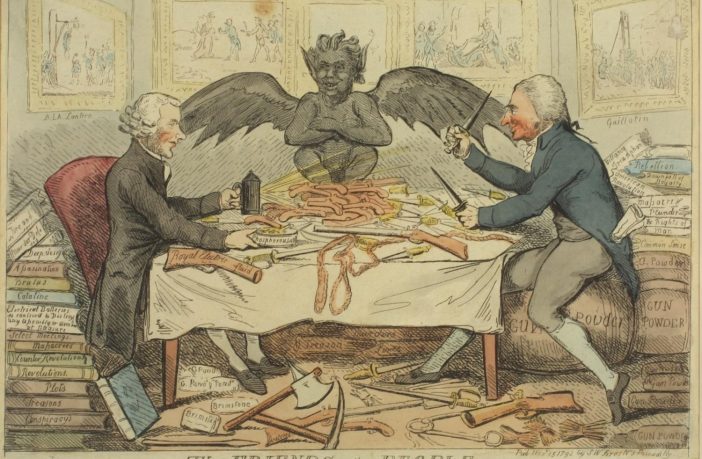Main picture: “The Friends of the People”, Isaac Cruikshank (1764–1811), Mary Mark Ockerbloom
While emigration into Britain has often been (and still is) associated with fear of oppression and escape from conflict, there is a general perception that emigration out of the country has been a rather more positive pursuit. Leaving Britain has long been associated with empire building, economic betterment – or retiring in the sunshine. But in fact, there also have been times when significant numbers of Britons felt the need to flee domestic persecution.
During the 1790s, in response to the French Revolution, a number of English political thinkers developed a reform movement in Britain. At the time, the nobility dominated both houses of parliament, and very few people had a vote.
Reformers set up societies throughout the country, such as the London Corresponding Society, and the Manchester and Sheffield Constitutional Societies. These agitated for moderate and radical reform of English government and the constitution. The most common demands were for the sovereignty of the people, fairer representation in parliament, universal male suffrage, and regular or annual parliaments. Religious tolerance was also a common addition.
In the early 1790s, these societies publicly congratulated France on its successful revolution. Some reformers were more radical still, visiting Paris and calling for the overthrow of all European despotic governments and universal freedom for all people – a world of revolutions.

Thomas Paine, by Matthew Pratt.
Kirby Collection
Activists Richard Price and Thomas Paine argued that sovereignty lay in the people. Any government that did not fulfil its duty to the people, they believed, could be rightfully overthrown. In his famous work Rights of Man (1791-92) Paine provocatively condemned monarchy and aristocracy and claimed that Britain had no constitution.
Government crackdown
The government and loyalist response to the radical movement, generated by fear and panic, was swift and dramatic. The loyalist press whipped up the negative reaction to radicalism. All English reformers were labelled Jacobins, a term associated with French terrorists and revolutionary intent. Ordinary people signed oaths of allegiance to the king and joined loyalist marches. They burned effigies of radicals, attacked their homes and, famously, set fire to radical dissenter Joseph Priestley’s premises in Birmingham.

Priestley’s home set ablaze in 1791.
Susan Lowndes Marques Collection
The state stepped in and free speech was quashed. Writers, printers and publishers were arrested and prosecuted for seditious libel under a Royal Proclamation against Seditious Writings issued by George III in 1792. Paine, meanwhile, fled to France after being tried in his absence and labelled an outlaw.
In an attempt to suppress this wave of radicalism, prime minister William Pitt introduced draconian measures known as his “Reign of Terror” (1793-5). Government spies were deployed to infiltrate the radical societies in Britain and the group of British radicals in Paris who met at White’s Hotel and were labelled the “British Club”.
The spies sent back (mostly false) reports about regicidal toasts and plots, the arming of radicals in Sheffield, support for an invasion of England by the British Club and so on. Committees of secrecy were appointed by the government to report on radical activity.
In 1793, radical conventions modelled on the French Convention were held in Edinburgh, with the aim of creating popular political assemblies around Britain. The ringleaders were arrested, convicted of treason and transported to Australia. They were mythologised as “the Scottish Martyrs”.
In 1794 the government suspended the Habeas Corpus law, which protects citizens from unlawful imprisonment. Radicals all over the country were pursued by officers of the law, some only just escaping in time, and some not. Fiery revolutionary Henry Redhead Yorke was arrested at Hull as he was about to leave for America, while Joseph Gales, proprietor of the radical Sheffield Register, managed to leave in time and emigrated to Philadelphia with his wife.
Taking flight
A number of leading English radicals were arrested and charged with high treason for which the punishment was to be hung, drawn and quartered. They were examined before the Privy Council and tried at what became known as the “Treason Trials” in 1794. All were acquitted (perhaps the jury were too squeamish to convict.)
But Yorke was not so lucky: he was left to languish in prison until July 1795, when he was convicted of seditious conspiracy and sentenced to two further years. His charge was reduced from treason and the trial packed with special jurors to ensure that this time, the government got what it wanted.
That same year, the so-called “Two” or “Gagging” acts were passed, restricting the right to hold public meetings – and more ominously, to extend the definition of treason to “imagining” the king’s death. Radicalism was effectively suppressed and forced underground, and many prominent radicals fled the country, mostly to North America.
This gives pause for thought at a time when the last Briton has just been released from Guantanamo Bay and new laws on surveillance and terrorism hover in the wings. Is legislation that criminalises “imaginings” once again on the horizon?
Britain, these days, is often seen as wrapped in the warm blanket of Western civilisation: a place where Enlightenment influenced humanitarianism, rights of free speech, the rule of law, and a longstanding democracy to keep citizens safe from tyranny. But history shows that such rights and freedoms must still be defended. Government suppression is rarely as far off as you might think.
![]()
Written by Amanda Goodrich, Lecturer in eighteenth-century history, The Open University
This article was originally published on The Conversation. Read the original article.



